Batman: The Complete Animated Series
by Randall | December 22, 2008 1:45 am
Warner Bros. (1992-1997), Warner Home Video (November 4, 2008), 17 discs, 2379 mins plus supplements, 1.33:1 original full frame ratio, Dolby Digital 2.0 Stereo Surround, Not Rated, Retail: $107.92
Storyboard:
Orphaned socialite Bruce Wayne wages a war on crime in Gotham City. Joined by a few trusted allies, he brings a sense of order to a town that teeters on the brink of chaos— for Gotham is a city caught between corrupt officials, powerful mobsters, and insane villains.
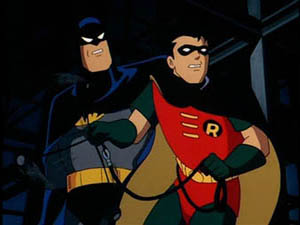
The Sweatbox Review:
Tim Burton’s 1989 Batman film was a milestone in many ways. It redefined the term “blockbuster” by smashing box office records and generating hundreds of millions of dollars in merchandizing. It finally put to rest the public’s perception of Batman as the object of ridicule, which he had been since the hugely popular 1960s camp-fest TV series. And, in addition to Frank Miller’s The Dark Knight Returns, which enjoyed unprecedented media coverage for a comic book, the film made grown-ups feel okay about reading comics. Best of all for fans of the character, it opened the door for the creation of his finest incarnation in Batman: The Animated Series.
It had been years since the last Batman cartoon had aired on television, that being Filmation’s The New Adventures of Batman in 1977; and even the various Super Friends shows, which had featured Batman, had finished their cycle in the mid-1980s. These earlier programs had been limited by the mandate of the networks that the cartoons be fully kid-friendly, totally devoid of serious storylines or interesting characterizations. The closest they ever got to presenting a good Batman story was in the final Super Friends program, 1985’s The Super Powers Team: Galactic Guardians. In the episode The Fear, writer Alan Burnett penned a story that was intended as a Batman pilot, and managed to work in some relatively sophisticated story concepts. The animation struggled to keep up with the script, but it was still a fine effort. Though the episode did not bring about a new series, it did show what could be achieved with a more mature Batman cartoon, even if network execs weren’t too interested.
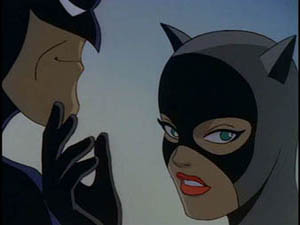
The 1989 film changed everything. Warner Brothers knew they were sitting on a goldmine, and they were in a prime position to take advantage. They had produced and distributed the film, their sister company DC Comics owned the character, and they also had an animation division that was doing high quality work for television like Tiny Toon Adventures. They also found a willing partner in Fox, who were happy to promote a daily afternoon line-up with one of the hottest properties around— and they didn’t mind skewing towards an older demographic. Warner Bros. Animation President Jean MacCurdy approached Bruce Timm and Eric Radomski, asking them if they would be interested in preparing a deluxe Batman cartoon. Though they had not worked together before, Timm found his enthusiasm for animation re-ignited following years of sometimes unfulfilling or frustrating work at various studios. He borrowed his Tiny Toons colleague Paul Dini to help him and writer friend Mitch Brian to develop a series bible. A pilot was prepared to demonstrate their stylized vision of the show, but it proved to not be necessary. Though a long approval process was expected, due to the negotiations being made between multiple partners, the show was greenlit before the pilot was shown to anyone. The pilot did achieve one thing, however— it earned Timm and Radomski the amazing opportunity to produce the show themselves, which is something they had not expected. It also provided the template for what became the show’s title-less opening.

Timm and Radomski had never produced before, but they and their colleagues were inspired by the opportunity to work on Batman. Following MacCurdy’s instruction, they planned a smart and sophisticated show. As their reference points, they used the old Fleischer Superman cartoons, film noir films, and pulp novels. They wanted to treat the actual source material respectfully, as well. Their Batman cartoon would have its light moments, but no camp. The stories of Bill Finger, Denny O’Neill, and Steve Englehart would prove to be the most influential, as they chose to tell stories of a driven man fighting for a city corrupted by crime and madness.
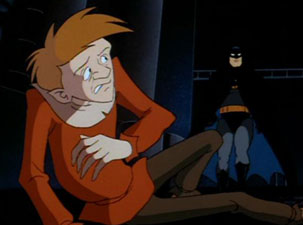
Visually, they took a “dark deco” approach to Gotham City that was similar in concept to the movie version, yet went into a more optimistic direction. Character design was done largely by Bruce Timm, but a number of others got involved as well. Lynne Naylor did some of the female designs, and comic artists Kevin Nowlan and Mike Mignola made contributions as well, along with artists at the studio. There is no doubt, though, that Timm’s design leadership led to a whole new take on cartoon superheroes. Previous attempts at doing superheroes for television had focused on making them fit the more realistic styles of contemporary comics; but Timm understood that it’s okay for cartoon characters to look like cartoon characters. The result was a cast of characters that looked like nothing seen on TV or in the comics before, and yet everyone still seemed remarkably iconic.

Several overseas studios, with variable results, handled animation on the first batches of episodes. AKOM was considered the worst of the bunch, while TMS was the classiest of the studios. Spectrum was also very good, and was actually largely made up of former TMS employees. TMS went on to do most of the final incarnation of the show themselves, and even shared in some extended pre-production work that season. The animation seen in Batman: The Animated Series was, at its best, ambitious for television. The limitation of lower frame rates was still apparent, but dynamic poses and staging did much to make the animation look even better than it was.
Fox decided to premiere Batman: TAS in prime time, and chose On Leather Wings to be the debut episode. This certainly met with the approval of the producers, who had positioned that episode as a showcase for what the show could achieve. The antagonist was Man-Bat, a figure loved by comics fans due to his conflicted status between hero and villain, but he was not so well known to the public. The relative newness of the “villain,” coupled with a dark, striking mood and some exceptional storyboarding and layout work, made the episode a stunner for the show’s new audience. The animation was also stunning, particularly Man-Bat flying throughout Gotham City with Batman precariously in tow behind him. Other standouts followed, such as the origin of seminal Batman villain Two-Face, and the character-redefining Heart Of Ice, which gave Mr. Freeze an origin that was brand new, yet seemed too ideal to have not been in place all along. The script for that episode, by Paul Dini, was unusually poignant, and it was the first episode to show off the directing talents of Bruce Timm. It was also the show’s first Emmy winner.
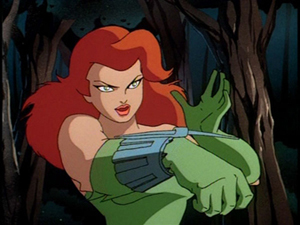
Poorer episodes did mingle with the superb ones, it must be admitted. I’ve never cared for the Dickensian The Forgotten, and the early Joker stories failed to find their mark. However, audiences also quickly got to see Batman’s coy relationship with a sympathetic Catwoman in the two-parter The Cat And The Claw, and the return of Adam West to the franchise in the terrific Beware Of The Grey Ghost. West voiced The Grey Ghost, who was basically a stand-in for The Shadow, an acknowledged inspiration for the Batman character. The episode was perfect for the type of pulp fiction the series strove to include, and was a nice nod to not only Batman’s origins, but also the “legacy” tradition of DC Comics superheroes.
The Joker’s Favor introduced Harley Quinn, a character who was originally intended to be a one-off gun moll but blossomed into a favorite, not to mention a DC Universe character who briefly starred in her own comic book. Though she has had a few good appearances in the comics, the animated series first gave her life and defined her character, while also providing a brand new way of looking at The Joker. More traditional was Robin’s Reckoning, which told the origin of Robin in flashback, but typical for this series also managed to find an emotional angle to exploit. Batman’s own origins also got explored in various episodes, where we learned more of his training either in the Orient, or with various mentors like the father of Zatanna.
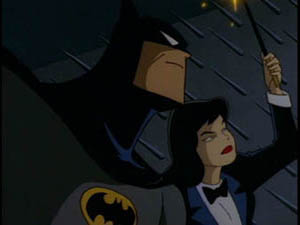
Even though Robin was initially downplayed on the show, Batgirl was also nicely introduced, in her own two-parter Shadow Of The Bat. One of my other favorites was the two-parter The Demon’s Quest, which adapted a classic 1970s Denny O’Neil comic book story in telling of the first confrontation between Batman and the man who would emerge as his most dangerous and cunning foe.
After the first seventy episodes aired successfully, Warner agreed to finance the production of another fifteen. This was done partially to help promote the Robin character, who would be featured in the upcoming Batman Forever film. The show was airing on Saturday mornings by this time, and was re-christened The Adventures Of Batman And Robin. Aside from tying in with the movie, Fox was hoping to attract younger kids to the show, as the demographics had been skewing more towards older kids until that point. The show went on to introduce the back-breaking villain Bane to the show, and brought back Batgirl and Mr. Freeze for worthy encores. With 85 episodes in the can, and a couple of Emmy awards, that was to be all for this animated incarnation of Batman. It’s final new episode aired in 1995.
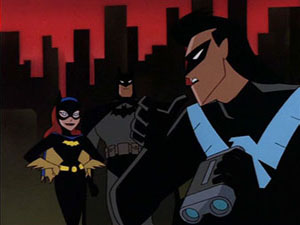
However, two years later, Batman fans would thrill to new episodes when the show moved to The Kids WB, sporting a new look. This version is officially known as The New Batman Adventures, but many also know it as Gotham Knights, since that was an early working title that the studio eventually tossed out. The show was on the new WB network, and at the time it was rumored that the budget had been shaven from what the show enjoyed in its Fox era. This seemed to explain the simpler character designs that emerged in TNBA, although according to interviews with Bruce Timm, he has indicated that he and his staff were interested in evolving the original BTAS style. This would largely match the style that they had developed for their concurrent Superman show— principally more angular, less detailed figures. The “dark deco” backgrounds of BTAS would remain, though, as would the shading of the figures, most of the voice cast, and music by Shirley Walker and her team.
I know I am not alone in stating that I much prefer the original character designs as opposed to the New ones. While the BTAS designs were instantly iconic (except perhaps for the movie-inspired Penguin), the new designs got away from the classic imagery for the villains (again, except for the Penguin). All of the rogues seemed to get white or blue (!) skin, Poison Ivy traded sexy curves for off-putting angles, the Joker lost his red lips while his eyes turned black, and so on. Nevertheless, the animation itself on these episodes is terrific, and for my money is the best in the whole Batman series. Bruce Timm has said that the new designs lent themselves better to more consistent animation, and he seems to be right. Even though I love the designs for BTAS, I honestly think that some of the animation in those shows was clunky, with much depending on which overseas studio did a particular episode. This is especially noticeable in the two-part episodes, which were often done by two different studios. In the final season, however, the animation using the new designs is uniformly smooth and impressive. According to the commentaries, this is principally due to TMS Animation in Japan getting more responsibility in this version of the show.

Story-wise, I have often heard fans say that this final batch of episodes just doesn’t measure up to the earlier shows. I tend to disagree, as BTAS had a few clunkers as well, while TNBA really has some outstanding stories. The new show also took a different approach to presenting the “Batman Family”. The Dick Grayson Robin was gone, but Dick returned as the more independent hero Nightwing. A new, younger Robin was brought forth, given the origin of the comics’ Jason Todd version (actually, this was the second Jason Todd origin that was created, but we won’t get into all that comic book continuity stuff); but the new animated Robin was given the name of comics’ current Batman sidekick, Tim Drake. Batgirl went from being an occasional guest-star to being Batman’s primary helper, accompanying him on most of his missions, while young Robin often had to stay home. Commissioner Gordon was still around, but looking much older.
Following a debut holiday-themed anthology, The New Batman Adventures really got going with an episode introducing the new Robin in Sins Of The Father. Then Cold Comfort brought back Mr. Freeze, last seen in the movie Batman/Mr. Freeze: Subzero. Nightwing showed up for the first time a couple of episodes later, teaming with an apparently reformed Catwoman, in Scratch My Back. Her all-black costume here harkened to what Timm had originally wanted to do with the character but had been hesitant to try, and her alter ego Selina Kyle finally got to be a brunette again, after being blonde (to match Michelle Pfeiffer’s Catwoman in Batman Returns) in BTAS. That’s all good, but I’ve never gotten the blue/white skin. Seriously. It looked weird on The Joker, and it looked no better on Catwoman. What were they thinking?
The one villain who really benefited from a new design was The Scarecrow. When he appeared in Never Fear, he had a hangman’s noose around his neck and looked scary as heck. Though it wasn’t true to any comics version that had appeared to date, it was a great take on the character, and helped to inspire The Scarecrow’s appearance in Batman Begins. Meanwhile, The Penguin returned to his comic book roots, looking more dapper again and not so much like the depraved flipper-handed nutter in the Tim Burton movie. Other episodes feature an inspired team-up between Killer Croc and Baby Doll (in Love Is A Croc), as well as appearances by The Ventriloquist, and new villains like Roxy Rocket (she made an okay bad gal, but was missing a psychological edge), and The Calendar Girl (much more the Bat-villain). They also did an episode with Firefly, but it’s really not too bad and does have a great Pinky And The Brain line delivered by Batgirl.
The best of New Adventures, however, is Over The Edge. Today, it offers proof that this incarnation of Batman was just as strong as the earlier one. It was an obvious dream story, opening with Commissioner Gordon and his cops chasing Batman at Wayne Manor after a horrible occurrence. I usually hate dream stories, but this one had such a great telling— including a kicker of an ending— that it manages to be my favorite of this set of episodes. Even if you think you know where the story is going… well, just watch and be delighted. On the other hand, there’s Critters, the episode that almost single-handedly makes people unfairly remember this incarnation of the show as being inferior. Yes, when people bad-mouth TNBA, they are probably thinking of this episode. This definitely falls under the category of “What were they thinking?” Farmer Brown and his beautiful, busty, and barefoot hillbilly daughter challenge Gotham with giant insects and farm animals. If that doesn’t sound bad enough, wait ‘til you see Brown’s hokey “Southern preacher” outfit and hear his corny dialog and the fiddle-heavy soundtrack!
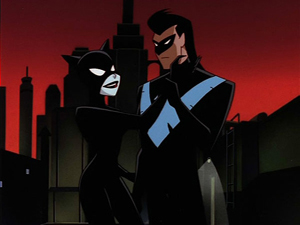
Another winner is Old Wounds, which finally told the tale of why Dick Grayson quit being Batman’s sidekick, and how Batgirl took his place. While it is fun to watch just for the continuity touches, including seeing a between-model Dick/Robin, there is genuine emotion in this episode that makes it rank near the top. Rather than just offering up some back-story, here Dick actually learned something new about Batman as the ending provided a nice twist. And then there is an episode that is just plain cool, offering up a classic 1970s Jack Kirby creation in The Demon Within. The Demon’s past would get explored wonderfully years later on Justice League, but here his human form of Jason Blood was simply shown as being a mysterious old friend of Bruce Wayne. This helped to ground what is otherwise an unusually fantasy-tinged story.
The final disc of the series offers an all-time geek blow-out spectacular! Legends Of The Dark Knight presented three incarnations of Batman— the 1950s Dick Sprang/60s TV show version, the Frank Miller Dark Knight version, and the regular animated series version. Each part was done in a different style, and Gary Owens and Michael Ironside got to speak Batman’s words, along with the usual Kevin Conroy. The best word to use to describe this episode is “joy”. They also slammed director Joel Schumacher here, which maybe comes off as a bit cheap, but you won’t think so if you hated his Batman And Robin movie. Legends was then followed by a Batgirl-Supergirl team-up, Harley Quinn’s origin story (adapted by Dini and Timm from their Mad love comic book story), and an episode with Steve Ditko’s offbeat character The Creeper. If you can ignore Critters (and I recommend you do), then what you are left with is an outstanding close to the animated adventures of the Bruce Timm-designed Batman.
When I first watched Batman: The Animated Series, it immediately became one of my favorite all-time shows. The designs were revolutionary for a superhero show, the writing surprisingly mature and involving. In the years that have passed, nothing has come along to make my estimation of the show any different. This one’s a classic, and probably the best overall version of Batman ever.
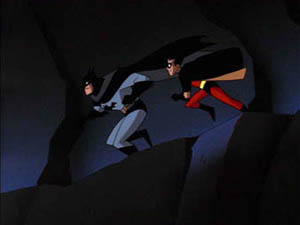
Is This Thing Loaded?
For the most part, what you get in this set is whatever appeared previously on DVD when the series was put out in four four-disc sets. Those sixteen discs are exactly the same in every way. Let’s break this down, then, by the original four-disc volumes (which is how these discs are still labelled).
Volume One
I find that when it comes to ongoing releases of TV shows on DVD I am satisfied to get a nice sprinkling of extras in each set. I would say that Batman: The Animated Series got it pretty much right. Of course, the first disc includes the original pilot that Timm and Radomski did for the show, and they both introduce this segment, entitled The Dark Knight’s First Flight (5:08). This first volume also has Audio Commentaries on two important episodes, and I couldn’t have picked better ones. Producers Timm and Radomski contribute a commentary for the very first produced (and shown) episode, On Leather Wings. This episode set the tone for the whole show, and the two producers explain what they were trying to achieve, and how satisfied they were with the result. They also note how organic BTAS looks now, compared to the gloss of later computer-assisted productions. The second disc has a commentary for Heart Of ice, where the producers are joined by writer Paul Dini. Dini and Timm note Boris Karloff and Vincent Price as inspirations for Mr. Freeze in this story. All involved say they were impressed by the animation that Spectrum did on this episode, but that their extra effort was one factor in putting these former TMS animators out of business.
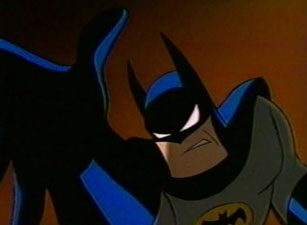
The “making of” featurette for this set comes on the second disc, and is called Batman: The Legacy Continues (18:01). It’s a pretty decent one, too, with lots of individuals discussing the show, including producers Timm and Radomski, writer Paul Dini, director Dan Riba, and DC Comics staffers like Mark Waid, Geoff Johns and Dan Didio. While there are lots of congratulations to hand out, one also does gain good insight on how the show came together and what made it unique. The third disc has a less interesting feature called Tour Of The Batcave, which provides barely useful voiceover and clips regarding Batman, Alfred, and props and vehicles on the show. The only bonus on the fourth disc is a set of now-antiquated trailers, under the heading Other Super Hero Favorites. (Trailers include those for Challenge Of The Super Friends, Justice League: Starcrossed, and Batman: Mystery Of The Batwoman.)
Volume Two
There are another four Audio Commentary tracks for key episodes. Producers Bruce Timm and Eric Radomski contribute their thoughts on Robin’s Reckoning Part 1. Although they initially seem at a bit of a loss as to what they would like to talk about, they do keep things going and end up delivering an informative track that discusses this important “origin” episode. They point out the comic book tributes, and their issues with the censors when portraying the deaths of Robin’s parents.
Kevin Altieri, on Heart Of Steel Part 2, joins Timm and Radomski for the next commentary. Almost Got ’Im gets a commentary by Timm, Radomski, and writer Paul Dini, who all enjoy talking about this offbeat episode. The final commentary is on Harley And Ivy, by producers Timm, Radomski, and director Boyd Kirkland. This was another lighter episode, and the contributors to this commentary certainly get a kick out of it. Among the more interesting aspects of these commentaries are their comments on how they can tell which animation contractors had a hand in an episode, and how they react when characters go off model.
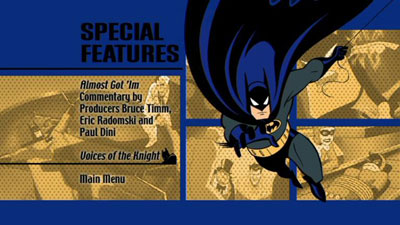
Then there are three Featurettes, one per each of the first three discs. Together, they make up a nice assortment of material. Each featurette is informative and avoids turning into a fluff piece. Robin Rising (8:21) features several of the producers and writers talking about Robin’s role in the show and how his character was developed, including Dick Grayson’s evolution into Nightwing and decisions about the later Tim Drake version of Robin. Gotham’s Guardians (10:12) looks at the supporting cast, with the producers and directors discussing Alfred, Commissioner Gordon, Harvey Bullock, Rene Montoya, Leslie Thompkins, and Selina Kyle. The show’s creators obviously have a fondness and appreciation for all these characters, who each add flavor to the show and help to illuminate a part of Batman’s character. Voices Of The Knight (8:05) examines the main characters. Unfortunately, we have to listen to yet another actor tell how he “always thought the drawings came first” (Efrem Zimbalist, Jr. in this case), but after that the featurette contains very worthwhile interviews with casting director Andrea Romano, and actors Kevin Conroy (Batman), Mark Hamill (The Joker), and Adrienne Barbeau (Catwoman). The last disc of Volume Two also has a few old DC animated Trailers.

Volume Three
Starting here, we get a nice animated main menu, as opposed to the boring and static main menus of the first two volumes. First, though, there is a featurette about Batgirl, entitled Gotham’s New Knight (7:38). Timm and Dini comment, as do director Boyd Kirkland, comics painter Alex Ross, and writer Michael Reaves. The second disc gets to the Commentaries, including an audio one for Read My Lips (with Timm, Reaves, Kirkland, and composer Shirley Walker), and a video one on House And Garden given by Timm, Dini, and Kirkland, and moderated by Jason Hillhouse. Disc Three offers another audio commentary by the same participants as the previous one, this time for Harlequinade. There’s never been any doubting that Harley Quinn is a favorite of Dini, and she’s obviously become a favorite of the others as well. The same disc hold Trailers for Batman Begins, as well as Samurai Jack: Season Two, and various DC superhero TV shows on DVD. The fourth disc in this volume carries no special features.

Volume Four
When selecting “Play All”, you may choose to watch either the original Batman: The Animated Series opening, or the opening for The New Batman-Superman Adventures. I love that, since I really admire the latter opening. If you select an individual episode, you are stuck with the BTAS opening. Many viewers will be happy that these episodes have been given chapters, unlike preceding volumes.
As far as actual extras, Disc 1 gives us Interactive Arkham Asylum. I was afraid that this was going to be yet another lame text-screen-with-a-“view clips”-option type of thing, but in fact this is a substantial feature. Yes, there are text screens for eleven villains, but the clips you can choose to see have 2-3 minutes each of the creators of the show discussing the characters and their redesigns. There is lots of good stuff here.
This volume has three very good Audio Commentaries by Bruce Timm, Paul Dini, and others. On Over The Edge, the creators discuss redesigning the cast for the new show, and how this particular episode was almost rejected since the team hates dream stories as much as I normally do; but in the end, this episode became a favorite of theirs, too. When the commentary for Critters starts, Timm notes (paraphrasing here), “You’re probably wondering why we would do a commentary for the most reviled episode in Batman history”. So sets the tone for 25 minutes of wonderful self-deprecation, although in the end Timm and the others end up defending Critters. They just about convinced me to re-evaluate it! Finally, the commentary for Legends Of The Dark Knight was a natural to do, and they all enjoy discussing what went into making this special tribute episode.
Bonus Disc
The seventeenth disc on this set is a new one, though it has a lot of old material. The main event is the new featurette Shades Of The Bat (22:52), which examines the many versions of Batman that have been animated over the years, starting with Filmation in the 1960s. Many knowledgeable people are interviewed, including naturally Paul Dini and Bruce Timm, but also Geoff Johns, Andy Mangels, Rich Fogel, Jerry Beck, and many more. Numerous clips are shown from various series, including scenes from the Super Friends (Galactic Guardians) episode The Fear, which was the precursor of sorts to Batman: The Animated Series. The featurette takes us right up to the current crop of direct-to-video DC Universe movies, but the focus of the featurette is on what set BTAS apart from the rest. Those that already have all the previous volumes of BTAS on DVD shouldn’t feel too slighted, but I thought it was a nice bonus and an interesting featurette.
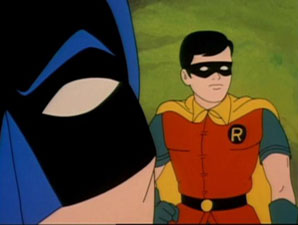
The balance of the disc is essentially advertising material that has been seen before. The teaser featurettes for Batman: Gotham Knight, Justice League: The New Frontier, and Wonder Woman are all here, as are a variety of trailers for Appleseed: Ex Machina, The Dark Knight, and some other DC Comics animated series.
Case Study:
First of all, this box set is gorgeous. I never cared for the individual cases that the original four volumes sets came in, never understanding why they were not more reflective of the style of the show. I mean, seriously. The brown & orange and blue & yellow color schemes just looked wrong, favoring bright colors instead of any sense of mystery. For this complete series set, we get a big, black box, just as it should be. The box is embossed with a popular image and logo from the show, which is something that should have been on these releases from the beginning. When you flip up the cover, you also see more artwork on the inside, with sort of a spot-varnished look. The case has a clear plastic slipcover with a color image of Batman on front and back, though the back one is covered with a glued-on paper sheet advertising the set’s contents. It looks easy enough to remove, as the glue is just a few globs, but I’ve left mine in place so far.

Getting inside to the black box, it opens somewhat like a cigar case, revealing two separate cases housing the discs. The two DVD cases hold two volumes each, reflecting how the discs first came out in their four-disc configurations. Each of these cases holds four trays with a disc on each side of each tray, so there is no overlapping. All discs are single-sided. The cases are clear, allowing for artwork to be seen inside and outside the cases. The second case also has the set’s bonus disc in its own “dish” inside the back cover.
Aside from the bonus disc, the other main attraction of getting the complete series box set is the inclusion of a 22-page soft cover book that serves as a guide to the discs’ contents (though with no episode synopses, unfortunately). It also has an introduction by series writer Alan Burnett, and oodles of artwork. Much of the art in the first half of the book simply looks like it could be from licensing guides, but the second half is all original production artwork (sketches, storyboards, and model sheets). It won’t replace anyone’s copy of Paul Dini’s Batman Animated book, but any Bat-fan is sure to appreciate it.
Ink And Paint:
Viewers will note that the episodes of this show generally got cleaner as the series progressed. Some earlier ones were really plagued with cel dirt, which showed up exceedingly well against the dark backgrounds. Nowhere is that more apparent than in both parts of Heart of Steel, with Part 2 looking like some scenes were shot in a snowstorm. This cel dust is part of the original camera negative, and Bruce Timm himself says on one of the commentaries that he would never want that dust digitally removed since it would take away from the character of the animation. So, do not fault the transfers. Aside from the cel dust, this show seemed a little prone to other physical artifacts, as if the camera operator could not be bothered to clean off the lens once in a while. Again, though, that is now part of the negative.

I always found this show to have a “soft” look to it, and the transfers on the DVDs do nothing to dispel that notion. There is some light grain, which is not necessarily a bad thing, and is mainly noticeable during pans. The compression quality is generally very good, with only an occasional shimmer or moiré effect. Truthfully, this show has never looked better than it does on this DVD set. It is not reference quality, no; but it is pretty good considering the limitations of 1990s television animation— before so much production was done on computers. Watching these more “organic”-looking shows is actually a breath of fresh air after viewing some of today’s almost overly clean, digitally produced entries. As much as I love the look of a show like Futurama, there is something to be said for being able to see some dust and smears in the animation.
The video quality noticeably improves for The New Batman Adventures. Timm even mentions in the commentaries that they had better control of dust when shooting the cels for these episodes. The picture also seems sharper, while being devoid of any significant shimmering, halos, or other compression artifacts. Still, there are bits of dust that find their way into the frame, but the prints themselves come off pretty well. These episodes look pretty nice.
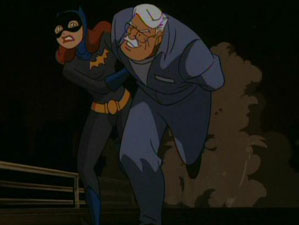
Scratch Tracks:
For the first twelve discs, comprising the first three volumes of the series’ initial box sets, Warner Home Video provided three language tracks, including the original English, as well as French and Spanish, with subtitles to match. The Dolby Surround mixes match up well against other adventure shows of that era, never threatening to be confused with a theatrical soundtrack but sounding nice nonetheless.
The true quality of the show is not in its sound effects, though, as well designed they were for a TV show. What really sets this show apart is the fine voice work (directed by Andrea Romano) and the scores by Shirley Walker. Both the regular cast and the frequent guest stars are uniformly outstanding. Kevin Conroy in particular established himself as the definitive Batman; but everyone on the show was generally excellent, and Romano always managed to find outstanding guest stars. Meanwhile, Warner Brothers sprang for full original scores for each episode, and the series thrives because of it. The result is what the producers always intended (and many reviews have said before this one): each episode sounds like a miniature motion picture.
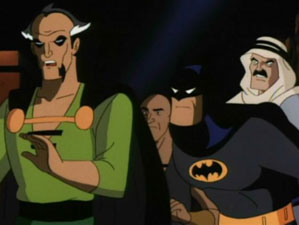
Soundtrack quality peaks in the final four discs. Unlike some animated shows done in stereo, you can actually tell it is so with these episodes. The soundtrack is just about as rich as you can get for a TV show, and when explosions occur (such as in Never Fear or Torch Song), the sound is forceful and fills the speakers nicely. The sound field is reasonably full for what it is, providing a pleasing sense of being in the show. It’s not quite the very best stereo track I’ve heard, but it’s quite satisfactory. These last four discs drop the Spanish audio, but still have subtitles in English, French, and Spanish.
Final Cut:
Batman: The Animated Series brought a new look to superhero shows and a new acceptance for cartoons that could be appreciated by all ages. It also spawned a surprisingly successful series featuring a future Batman in Batman Beyond, not to mention a string of shows set in the same continuity starring Superman and later the Justice League, which also became a tremendously cool program. And, without these shows, it is unlikely we would have ever seen series with the Teen Titans or Legion Of Superheroes. Even The Spectacular Spider-Man owes some of its cartoony sensibility to the path forged by the Batman artists.
While the odd episode is weaker than the others, there is no doubt that Batman: TAS contains some of the very best superhero cartoons ever made. This is one show that was made by people who were familiar with the characters and the comic book stories, and the resulting cartoons contain a richness of writing and characterization that is respectful of the source material. Fortunately, these artists and writers were also extremely talented in their own right, and they crafted many superb tales that remain the benchmark for superhero cartoons.
Technically, this is indeed a complete series set, so one shouldn’t complain. Nevertheless, as a reviewer, I must point out that this set does not include the superb World’s Finest story that is considered to be officially a part of Superman: The Animated Series, but was done at the same time that The New Batman Adventures was coming out. Of course, that “movie” did get its own video release, and also appears on the Superman sets, but it would have been a nice bonus for fans who don’t collect Superman. Perhaps more importantly, it would have been nice to have seen the two Batman movies done by the creators of the show, namely Batman: Mask Of The Phantasm and Batman/Mr. Freeze: Subzero. These shows very much reflected and affected the continuity of the show, and it would have been nice to see them included here; but I do understand that as direct-to-video offerings (Phantasm even had a brief theatrical release), they do stand apart and are available elsewhere.
Aside from those petty concerns, one has to be impressed by this Complete Series set. For those that were left unimpressed by the Flintstones’ set released around the same time, rest assured that Warner got it right for Batman. Aside from holding every episode of a beloved program, and numerous pre-existing bonus features that provide good insight into the production of the show, the packaging of this set is impressive, and there are just enough extra goodies there to entice fans into a double dip. At a nice price point, this is a great deal whether you’re looking to sell your old sets or to complete your collection.
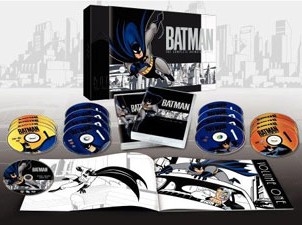 | ||
 [1] [1] |
- [Image]: http://www.amazon.com/exec/obidos/ASIN/B001CTXUTQ/animatedviews-20
Source URL: https://animatedviews.com/2008/batman-the-complete-animated-series/